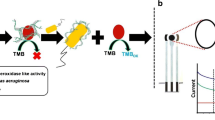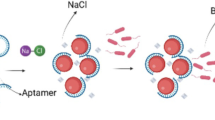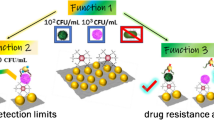Abstract
The rapid detection of bacterial strains has become a major topic thoroughly discussed across the biomedical field. Paired with the existence of nosocomial pathogen agents that imply extreme medical and financial challenges throughout diagnosis and treatment, the development of rapid and easy-to-use sensing devices has gained an increased amount of attention. Moreover, antibiotic resistance considered by World Health Organization as one of the “biggest threats to global health, food security, and development today” enables this topic as high priority. Pseudomonas aeruginosa, one of the most ubiquitous bacterial strains, has various quorum-sensing systems that are a direct cause of their virulence. One of them is represented by pyocyanin, a blue pigment with electroactive properties that is synthesized from early stages of bacterial colonization. Thus, the sensitive detection of this biomarker could enable a personalized and efficient therapy. It was achieved with the development of an electrochemical sensor based on a thermosensitive polymer, modified with Au/Ag nanoalloy for the rapid and accurate detection of pyocyanin, a virulence biomarker of Pseudomonas aeruginosa. The sensor displayed a linear range from 0.12 to 25 μM, and a limit of detection of 0.04 μM (signal/noise = 3). It was successfully tested in real samples spiked with the target analyte without any pretreatment other than a dilution step. The detection of pyocyanin with high recovery in whole blood in a time frame of 5–10 min from the moment of collection was performed with this electrochemical sensor.

Graphical abstract






Similar content being viewed by others
References
Webster TA, Sismaet HJ, Conte JL, Chan I ping J, Goluch ED. Electrochemical detection of Pseudomonas aeruginosa in human fluid samples via pyocyanin. Biosens Bioelectron. 2014;60:265–70.
Dong D, Zou D, Liu H, Yang Z, Huang S, Liu N, et al. Rapid detection of Pseudomonas aeruginosa targeting the toxA gene in intensive care unit patients from Beijing, China. Front Microbiol. 2015;6:1100.
Workentine M, Poonja A, Waddell B, Duong J, Storey DG, Gregson D, et al. Development and validation of a PCR assay to detect the prairie epidemic strain of Pseudomonas aeruginosa from patients with cystic fibrosis. J Clin Microbiol. 2016;54(2):489–91.
Ciui B, Tertiş M, Cernat A, Sǎndulescu R, Wang J, Cristea C. Finger-based printed sensors integrated on a glove for on-site screening of Pseudomonas aeruginosa virulence factors. Anal Chem. 2018;90(12):7761–8.
Gandouzi I, Tertis M, Cernat A, Bakhrouf A, Coros M, Pruneanu S, et al. Sensitive detection of pyoverdine with an electrochemical sensor based on electrochemically generated graphene functionalized with gold nanoparticles. Bioelectrochemistry. 2018;120:94–103.
Cernat A, Tertis M, Gandouzi I, Bakhrouf A, Suciu M, Cristea C. Electrochemical sensor for the rapid detection of Pseudomonas aeruginosa siderophore based on a nanocomposite platform. Electrochem Commun. 2018;88:5–9.
Lau GW, Hassett DJ, Ran H, Kong F. The role of pyocyanin in Pseudomonas aeruginosa infection. Trends Mol Med. 2004;10(12):599–606.
Dietrich LEP, Price-Whelan A, Petersen A, Whiteley M, Newman DK. The phenazine pyocyanin is a terminal signalling factor in the quorum sensing network of Pseudomonas aeruginosa. Mol Microbiol. 2006;61(5):1308–21.
Sismaet HJ, Pinto AJ, Goluch ED. Electrochemical sensors for identifying pyocyanin production in clinical Pseudomonas aeruginosa isolates. Biosens Bioelectron. 2017;97:65–9.
Seviour T, Doyle LE, Lauw SJL, Hinks J, Rice SA, Nesatyy VJ, et al. Voltammetric profiling of redox-active metabolites expressed by Pseudomonas aeruginosa for diagnostic purposes. Chem Commun. 2015;51(18):3789–92.
Jayaseelan S, Ramaswamy D, Dharmaraj S. Pyocyanin: production, applications, challenges and new insights. World J Microbiol Biotechnol. 2014;30(4):1159–68.
Micek ST, Lloyd AE, Ritchie DJ, Reichley RM, Fraser VJ, Kollef MH. Pseudomonas aeruginosa bloodstream infection: importance of appropriate initial antimicrobial treatment. Antimicrob Agents Chemother. 2005;49(4):1306–11.
Martínez-Solano L, Macia MD, Fajardo A, Oliver A, Martinez JL. Chronic Pseudomonas aeruginosa infection in chronic obstructive pulmonary disease. Clin Infect Dis. 2008;47(12):1526–33.
Chua SL, Liu Y, Yam JKH, Chen Y, Vejborg RM, Tan BGC, et al. Dispersed cells represent a distinct stage in the transition from bacterial biofilm to planktonic lifestyles. Nat Commun. 2014;5(1):4462.
Alatraktchi FA, Andersen SB, Johansen HK, Molin S, Svendsen WE. Fast selective detection of pyocyanin using cyclic voltammetry. Sensors (Switzerland). 2016;16(3):408–18.
Sharp D, Gladstone P, Smith RB, Forsythe S, Davis J. Approaching intelligent infection diagnostics: carbon fibre sensor for electrochemical pyocyanin detection. Bioelectrochemistry. 2010;77(2):114–9.
Alatraktchi FA, Johansen HK, Molin S, Svendsen WE. Electrochemical sensing of biomarker for diagnostics of bacteria-specific infections. Nanomedicine. 2016;11(16):2185–95.
Alatraktchi FAZ, Noori JS, Tanev GP, Mortensen J, Dimaki M, Johansen HK, et al. Paper-based sensors for rapid detection of virulence factor produced by Pseudomonas aeruginosa. PLoS One. 2018;13(3):1–9.
Zheng L, Cai G, Wang S, Liao M, Li Y, Lin J. A microfluidic colorimetric biosensor for rapid detection of Escherichia coli O157:H7 using gold nanoparticle aggregation and smart phone imaging. Biosens Bioelectron. 2019;124–125:143–9.
An L, Zhao TS, Zeng L. Agar chemical hydrogel electrode binder for fuel-electrolyte-fed fuel cells. Appl Energy. 2013;109:67–71.
Raphael E, Avellaneda CO, Manzolli B, Pawlicka A. Agar-based films for application as polymer electrolytes. Electrochim Acta. 2010;55(4):1455–9.
Moon WG, Kim GP, Lee M, Song HD, Yi J. A biodegradable gel electrolyte for use in high-performance flexible supercapacitors. ACS Appl Mater Interfaces. 2015;7(6):3503–11.
Tani Y, Tanaka K, Yabutani T, Mishima Y, Sakuraba H, Ohshima T, et al. Development of a D-amino acids electrochemical sensor based on immobilization of thermostable D-proline dehydrogenase within agar gel membrane. Anal Chim Acta. 2008;619(2):215–20.
Li Y, Wang Z, Sun L, Liu L, Xu C, Kuang H. Nanoparticle-based sensors for food contaminants. TrAC Trends Anal Chem. 2019;113:74–83.
Thanh TD, Balamurugan J, Hien H Van, Kim NH, Lee JH. A novel sensitive sensor for serotonin based on high-quality of AuAg nanoalloy encapsulated graphene electrocatalyst. Biosens Bioelectron 2017;96:186–193.
Tertiş M, Florea A, Adumitrăchioaie A, Cernat A, Bogdan D, Barbu-Tudoran L, et al. Detection of dopamine by a biomimetic electrochemical sensor based on polythioaniline-bridged gold nanoparticles. Chempluschem. 2017;82(4):561–9.
Tertiș M, Cernat A, Lacatiș D, Florea A, Bogdan D, Suciu M, et al. Highly selective electrochemical detection of serotonin on polypyrrole and gold nanoparticles-based 3D architecture. Electrochem Commun. 2017;75:43–7.
Muller M. Premature cellular senescence induced by pyocyanin, a redox-active Pseudomonas aeruginosa toxin. Free Radic Biol Med. 2006;41(11):1670–7.
Yang Y, Yu YY, Wang YZ, Zhang CL, Wang JX, Fang Z, et al. Amplification of electrochemical signal by a whole-cell redox reactivation module for ultrasensitive detection of pyocyanin. Biosens Bioelectron. 2017;98:338–44.
Funding
This work was supported by grants of the Romanian National Authority for Scientific Research and Innovation, CNCS/CCCDI-UEFISCDI, project number PN-III-P1-1.2-PCCDI2017-0407 (INTELMAT).
Author information
Authors and Affiliations
Corresponding authors
Ethics declarations
Conflict of interest
The authors declare that they have no conflict of interest.
Additional information
Publisher’s note
Springer Nature remains neutral with regard to jurisdictional claims in published maps and institutional affiliations.
Rights and permissions
About this article
Cite this article
Cernat, A., Canciu, A., Tertis, M. et al. Synergic action of thermosensitive hydrogel and Au/Ag nanoalloy for sensitive and selective detection of pyocyanin. Anal Bioanal Chem 411, 3829–3838 (2019). https://doi.org/10.1007/s00216-019-01857-4
Received:
Revised:
Accepted:
Published:
Issue Date:
DOI: https://doi.org/10.1007/s00216-019-01857-4




